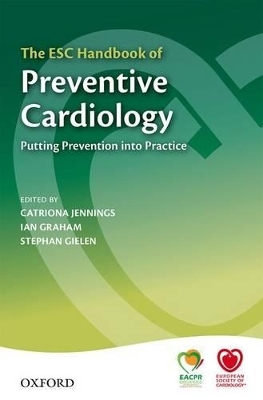
ESC Handbook of Preventive Cardiology
Oxford University Press (Verlag)
978-0-19-967403-9 (ISBN)
- Titel ist leider vergriffen;
keine Neuauflage - Artikel merken
The »ESC Handbook of Preventive Cardiology« is a 'how-to' manual for busy healthcare professionals. Complementing the 2012 Joint European Guidelines on cardiovascular disease prevention and in line with recommendations from the European Association of Cardiovascular Prevention and Rehabilitation, it is an invaluable source of tools and skills to assist with the delivery of effective cardiovascular disease prevention.
While acknowledging that cardiovascular disease prevention efforts must be complemented by societal and community based strategies, this handbook focuses on practical strategies that can be used in clinical settings. Concise and easily accessible, it guides readers through the patient and family pathway - from patient identification, recruitment of the patient and family, assessing lifestyle and risk factors, to managing lifestyle change, reducing risk factors, and compliance with cardio-protective drug therapies. Information on how to deliver a health promotion workshop programme and run a supervised exercise programme is also included.
Previously published as »Preventive Cardiology: A practical manual« and now fully revised and updated and packed with checklists and diagrams, such as risk estimation charts, The »ESC Handbook of Preventive Cardiology« helps health workers contribute in real and practical ways to the prevention of artherosclerotic cardiovascular disease.
This print edition of The »ESC Handbook of Preventive Cardiology, Putting Prevention into Practice« comes with access to the online version on Oxford Medicine Online, for as long as the edition is published by Oxford University Press. By activating your unique access code, you can read and annotate the full text online, follow links from the references to primary research materials, and view, enlarge and download all the figures and tables.
Catriona Jennings is a cardiac specialist nurse and the European Research Nurse coordinator for EUROACTION and EUROASPIRE III in the Department of Cardiovascular Medicine at the National Heart and Lung Institute, Imperial College London.
Ian Graham qualified in medicine at Trinity College, Dublin. He trained in the Adelaide and St. Vincent's Hospitals in Dublin, and at Papworth Hospital in Cambridge, England. He held the post of MRC Research Fellow and, later, Director of Research at St. Vincent's Hospital and was also Director of Research at the Irish Heart Foundation. He is past president of the Irish Heart Foundation, the Irish Hyperlipidaemia Association, and of the Dublin University Biological Association. He also founded the Irish Cardiac Surgery Register. Awards and distinctions have included a Medical Research Council Fellowship, an ISFC Cardiovascular Epidemiology Fellowship, the first Stokes Lectureship in Dublin and an EU Travelling Fellowship at Erasmus University in Rotterdam, and Fellowships of the European Society of Cardiology and of the American College of Chest Physicians. He is an honorary Fellow of Trinity College, Dublin, Ireland.
Stephan Gielen is the Deputy Director & Head of Department of the University Clinic & Clinic for Internal Medicine III in Halle (Saale), Germany. He was President of the European Association for Cardiovascular Prevention and Rehabilitation from 2012-2014, and is Speaker of the Working Group of Preventive Cardiology of the German Society of Cardiology, and Vice Speaker of the Working Group on Cardiac Diseases in the Elderly. After his medical education at the University of Bochum, Germany, Harvard Medical School, Boston, and Baylor College of Medicine, Houston, USA, he started his internship at Heidelberg University before moving to Leipzig in 1997.
Part 1. What is prevention and why do we need it?
1. Why do we need CVD prevention?
2. What is a high risk patient?
3. How to assess risk
4. Biomarkers in risk assessment
5. Imaging in risk assessment
6. Erectile dysfunction and cardiovascular risk
7. Priorities and targets
Part 2. Practical aspects of prevention
8. Behavioural strategies to support and sustain lifestyle change
9. Engaging individuals, families and carers in prevention
10. Smoking cessation
11. Diet and weight: Major lifestyle challenges
12. Helping people to become more physically active
13. Blood pressure management
14. Lipid management
15. Blood glucose management
16. Drug therapies to reduce risk: Evidence and practicalities
17. Identifying and managing psychosocial factors
18. Putting educational strategies into practice
Part 3. Setting up Preventive Cardiology Initiatives
19. The Global Care Pathway and how it works in practice
20. Examples of the initiatives in different care settings:Starting preventive and rehabilitative care in hospital
21. Examples of initiatives in different care settings:Community
22. Ensuring quality of interventions
| Erscheint lt. Verlag | 28.7.2016 |
|---|---|
| Reihe/Serie | The European Society of Cardiology Textbooks |
| Verlagsort | Oxford |
| Sprache | englisch |
| Maße | 135 x 195 mm |
| Gewicht | 256 g |
| Einbandart | kartoniert |
| Themenwelt | Medizinische Fachgebiete ► Innere Medizin ► Kardiologie / Angiologie |
| Schlagworte | Gesundheitsförderung • Herz-Kreislauf-Erkrankungen • Kardiologie • kardiovaskulär • Präventive Medizin |
| ISBN-10 | 0-19-967403-5 / 0199674035 |
| ISBN-13 | 978-0-19-967403-9 / 9780199674039 |
| Zustand | Neuware |
| Haben Sie eine Frage zum Produkt? |
aus dem Bereich


